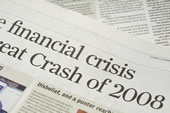 How time flies. Almost exactly 5 years ago on November 21st, 2008, I was sitting alone in yet another hotel on a business trip in a city that I can’t even remember. CNN was on TV as I wrote the following in a blog post with the title S&P 500 at 750:
How time flies. Almost exactly 5 years ago on November 21st, 2008, I was sitting alone in yet another hotel on a business trip in a city that I can’t even remember. CNN was on TV as I wrote the following in a blog post with the title S&P 500 at 750:
While the present looks bleak, the potential for future returns is looking brighter and brighter for long-term investors. The opposite was true a few years ago. If you’re young and still putting money away, this is a good thing! (Although adequate emergency funds should be your first goal.)
Here are selected comments on that post that I admit gave me some doubt:
However, EPS estimates, and therefore valuations, are ridiculously high.
Putting money into a market that represents the old model right now seems like pure folly.
This bear market will last 3-12 years!
I think it’s funny that many of you are down 50% and think that you will break even in a few years, or justify by saying “I’m for the long term”. […] Also, most of the dividends being advertised are based on fantasy (again), just like the EPS, because companies will be cutting them a lot to survive. So no, the S&P isn’t cheap to buy and buy-and-hold is really dead.
Why NOT hold out until the fundamentals of the economy are back on a solid footing? It may take 10 years or MORE. But WHY try to catch it here? It’s reckless gambling, not sound investing. You won’t miss the opportunity of a lifetime. Stocks won’t go up forever without you. Jonathan, it is prudent at this point to remain out of the market with anything but play money. EPS estimates for 2009 may be delusional, and it may not be… but there is NO evidence to the positive, and much to the negative.
Today, the S&P 500 index is at 1,800 and that excludes dividends. I’m amazed at how much my investment portfolio has grown since those scary months. Now, this is not to say the S&P 500 could go back to 750 in the next 5 years again. It could go up, it could go down, I don’t know and I’m not saying I’m good at making market forecasts. My lessons are:
- No matter what price level, people will be able to use numbers and statistics to support the market being simultaneously grossly overvalued or grossly undervalued. Even today, I could find one article saying that cash balances are high and P/E ratio is quite reasonable, while another will point out that cyclically-adjusted P/E ratios are really high on a historical level. I would say that future returns don’t look quite as good at they did in 2008, but that doesn’t mean you shouldn’t invest.
- Buy, hold, and rebalance. I did not sell and go all cash before the crash. Neither did I buy in and go 100% stocks at the bottom. What I am proud of is that I rebalanced my portfolio through the entire ride. This meant I never sold any stocks in 2008, but it also means that if I was stock-heavy right now relative to 70/30 or 80/20 or whatever target asset allocation I picked, I would still rebalance back to the target allocation even if it meant selling stocks and buying bonds, however currently unpopular.
 The Best Credit Card Bonus Offers – 2025
The Best Credit Card Bonus Offers – 2025 Big List of Free Stocks from Brokerage Apps
Big List of Free Stocks from Brokerage Apps Best Interest Rates on Cash - 2025
Best Interest Rates on Cash - 2025 Free Credit Scores x 3 + Free Credit Monitoring
Free Credit Scores x 3 + Free Credit Monitoring Best No Fee 0% APR Balance Transfer Offers
Best No Fee 0% APR Balance Transfer Offers Little-Known Cellular Data Plans That Can Save Big Money
Little-Known Cellular Data Plans That Can Save Big Money How To Haggle Your Cable or Direct TV Bill
How To Haggle Your Cable or Direct TV Bill Big List of Free Consumer Data Reports (Credit, Rent, Work)
Big List of Free Consumer Data Reports (Credit, Rent, Work)
The market went down another 11% or so from there. It has been a wild ride. I hope none of those comments came from me!
I like your takeaways. Nothing can lie like numbers and data.
Another moral is relativism counts. You may not know how far the market may pull back, but the further it does, the better a buy it becomes. So yeah, a 10-20% correction is a decent buying opportunity, and a great time to re-balance, but at 50% down from a high, the market is ALWAYS a screaming buy, regardless of EPS or p/e or any other fundamental measure. Sure, it can take time to recover, maybe even a long time, but history shows it eventually will. And if you don’t have a long time to wait for the recovery, your asset allocation is off and you shouldn’t have lost 40-50% to begin with.
With markets cycles, history repeats itself time and again. Remember that, next time we see a major bear market.